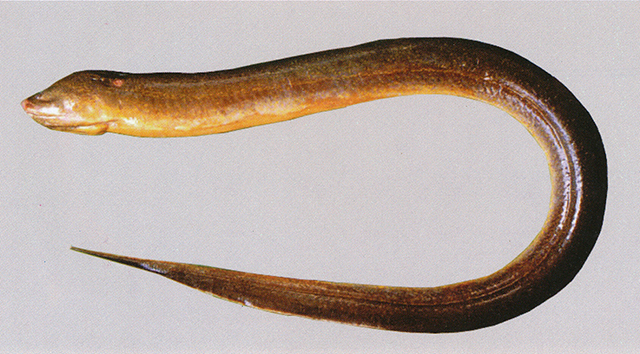| Synbranchidae (Swamp-eels) |
| 100 cm SL (male/unsexed) |
|
demersal; freshwater; brackish; depth range - 3 m, potamodromous |
| Asia: India to China, Japan, Malaysia and Indonesia. Probably occurring in Bangladesh. |
|
Anguilliform body; no scales; no pectoral and pelvic fins; dorsal, caudal and anal fins confluent and reduced to a skin fold; gill openings merged into single slit underneath the head (Ref. 27732). Rice paddy eels are red to brown with a sprinkling of dark flecks across their backs; large mouths and small eyes (Ref. 44091). |
| Found in hill streams to lowland wetlands (Ref. 57235) often occurring in ephemeral waters (Ref. 44894). Adults are found in medium to large rivers, flooded fields and stagnant waters including sluggish flowing canals (Ref. 12975, 12693), in streamlets and estuaries (Ref. 41236). Benthic (Ref. 58302), burrowing in moist earth in dry season surviving for long periods without water (Ref 2686). Occasionally dug out in old taro fields, in Hawaii, long after the field has been drained; more frequently observed in stream clearing operations using heavy equipment to remove large amounts of silt and vegetation where the eels are hidden (Ref. 44091). Nocturnal predators devouring fishes, worms, crustaceans, and other small aquatic animals (Ref. 44091); also feed on detritus. Are protandrous hermaphrodites. The male guards and builds nest or burrow (Ref. 205). Marketed fresh and can be kept alive for long periods of time as long as the skin is kept moist (Ref. 12693). Good flesh (Ref. 2686). Important fisheries throughout Southeast Asia (Ref. 57235). |
|
Least Concern (LC); Date assessed: 10 November 2020 Ref. (130435)
|
| harmless |
Source and more info: www.fishbase.org. For personal, classroom, and other internal use only. Not for publication.
